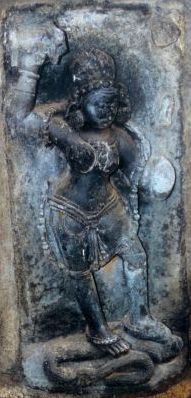 |
 |
The Path of the Yogini The Spirit of the Mother and Grandmother < back to The Path of the Yogini
When I think of Nepal I remember the women who carry this spirit of Mai, the Mother and Ajima, grandmother, and who I experience as living embodiments of Goddess Durga in all Her forms. These women, whose lives are by no means easy, mirror my own love and devotion towards Goddess. Watching them pray and speak to Durga , Lakshmi, Saraswati, Kali, Vajrayogini, the Matrikas, Navadurgas and other countless Goddesses affirms that what I am feeling is real, mysterious and profound. At each temple, at each roadside shrine, at each stone that has been worshiped for thousands of years as Goddess throughout the Valley, I encountered women dressed in vibrant red hues—cherry, hibiscus, crimson, ruby, pomegranate. Women on their knees in prayer, their eyes closed in deep devotion, their lips trembling slightly as they ask for Her blessing. Women feeding the Goddess—offering rice, chapatis, lentil-based sweets, fruit, and coconut. Women honoring Her light with ghee lamp flames burning from cotton wicks that they themselves had grown and so carefully and mindfully twisted while sitting on a doorstep chatting with their neighbors about life’s trials and joys. Women waving incense and teaching their young daughters how to hold the incense sticks and wave them in a circular movement to please the Goddess, the wisps of smoke wafting through the womblike inner sanctum filling the air with sandalwood and jasmine scents. Women carrying plates piled with orange and yellow marigolds and red hibiscus, tucking the blossoms into every available crevice of the Goddess’majestic stone form, especially at Her feet and on Her head. Women reciting the sacred texts, muttering chants (mantras), whispering their fears and desires to the Goddess of their heart. Women bowing their heads to the deity’s wet and sticky red feet and breasts, Goddess’ now blood-red body lovingly smeared with red vermillion powder and coconut milk by thousands of devotees. Countless women—young and old, light and dark-skinned, poor, middle class, rich, Buddhist and Hindu—all pressing their red-marked foreheads to the Goddess’ brow expressing their deep devotion and love and asking for Her grace. In the Valley the presence of the Mai and Ajima is undeniable. The Shakta Tantra texts state that all women are inherently Shakti, so one might hope that today women in twenty-first century Nepal are still perceived as living embodiments of Goddess. However, for the most part, the Nepalese, Newari, Tibetan and ethnic minority women I encountered were sadly not treated as Goddesses. Suffering, abuse, sex trafficking, poverty, debilitating illness are too often the horrifying reality of life for them, yet despite the abuses and injustice, the women remain devoted to Goddess. Life is hard in the Valley, but women’s relationship to the Divine is what carries them through. It is Goddess who assuages their sorrow over losing a child; their worries about not having enough food to feed their families. It is She who listens to their fears about their health and the difficulties and pain they experience in their marriages or daily lives. It is Goddess who protects and embraces them. It is Goddess who smiles when they relate tales of love and caring, who pats them on the back when they share their successes and accomplishments, who inspires them to dance, laugh, play and make love. It is Devi whose shoulder and breast they can cry on, whose four to eighteen arms hold and caress them as they weep their sorrows about sickness, death, and poverty. It is Goddess who is everything to them: a listener, a guide, a mother, a lover, a friend. The Mai and Ajima in Her myriad forms bestows Her blessings in an endless, countless flow and women worship Her with deep gratitude and appreciation as they have done for millennia. ~~
Laura Amazzone is an author, teacher, jewelry artist, and Yogini. She completed her master’s degree in philosophy and religion, with an emphasis in women’s spirituality at the California Institute of Integral Studies in 2001. Her book, Goddess Durga and Sacred Female Power (Baltimore: Hamilton Press, 2010), explores the millennia-old rituals and manifestations of the Goddess in South Asia and honors female creative & sexual power as a divine force. Laura teaches classes and workshops on Goddess spirituality and Eastern religious traditions and is adjunct faculty in the Yoga & Philosophy program at Loyola Marymount University in Los Angeles. She has published numerous articles discussing myth, ritual, adornment, and the significance of South Asian Goddesses as divine models of female empowerment. She blogs for the Religion section of the Huffington Post. She lives in Venice, California. www.lauraamazzone.com < back to The Path of the Yogini
|
|||
Home | About Us | Features | Ask
Our Team | Inspiration
& Practice | Women of Vision | Resources
Copyright 2011 Feminist.com. All rights reserved.
